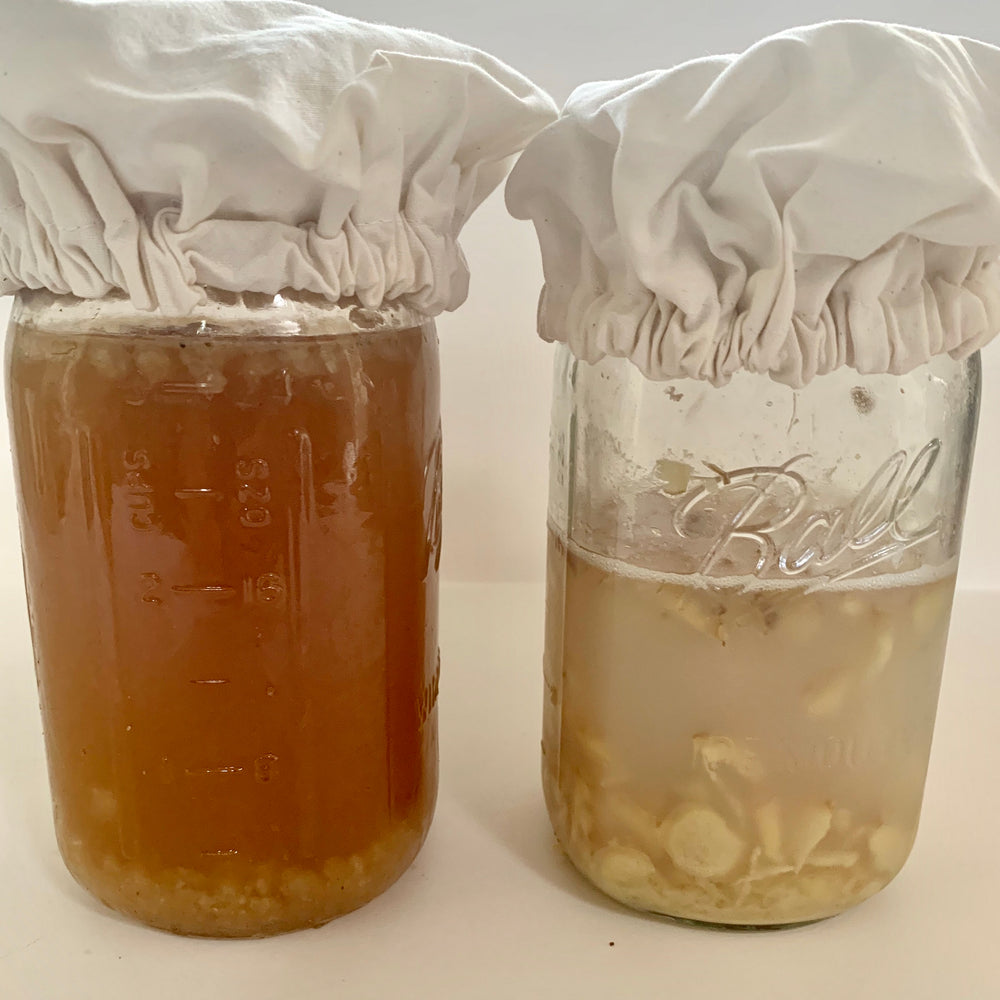
Ginger Beer Plant vs. Ginger Bug
What exactly is the difference between a ginger beer plant and the ginger bug?
In basic terms, the Ginger Beer Plant is a culture that cannot be made.

It was passed down through generations over the centuries. It has many strains of bacteria and yeast that coexist naturally in a type of polysaccharide matrix that looks like tiny pebbles.
A ginger bug on the other hand is simply made from fresh ginger root and sugar.

The natural bacteria and yeasts within the ginger root creates an active liquid that you can use to ferment other types of sugar water, teas, juices, etc.
There's obvious differences, but I wanted to see exactly how differently they behaved, so I did two side by side tests and the results were very interesting.
Test 1 - Ginger beer plant grains vs Ginger bug

The first test was where the Ginger beer plant had home court advantage.
I wanted to see if an active ginger bug could ferment a standard ginger beer sugar recipe:
Ginger beer plant
- 2 tablespoons of ginger beer plant
- 8 tablespoons of a standard sugar recipe (cane, rapadura and palm sugar)
- 4 cups of water
Ginger bug
- 1/4 cup of active ginger bug liquid
- 8 tablespoons of a standard sugar recipe (cane, rapadura and palm sugar)
- 4 cups of water
Results
The ginger beer plant did it usual thing and after 2-3 days the liquid was fully fermented. It was sour, fizzy and tangy - exactly how it should be.
The ginger bug however had major issues due to the amount of sugar. There wasn't much activity for the first 48 hours and then it turned to syrup. It continued to try to work its way though, but it become an unappealing syrupy mess with a few bubbles.

Test 2 - Ginger beer plant liquid vs Ginger bug liquid

So I felt like the first test was not really fair to the poor ginger bug as it was NOT a typical ginger bug recipe and it was comparing the grains to the ginger bug juice.
This time I compared apples to apples. I compared active ginger beer juice (not the grains) with the active ginger bug juice. I also used a mix of water and apple juice which is much more typical recipe for the ginger bug.
Ginger beer plant
- 1/4 cup of finished ginger beer plant juice
- 4 cups of filtered down apple juice
Ginger bug
- 1/4 cup of active ginger bug liquid
- 4 cups of filtered down apple juice
Results
The results were very interesting. The ginger bug juice fermented faster than the ginger beer plant juice. After about 2 days, the ginger bug was the clear winner as it had visibly more bubbles and it tasted more fermented than the ginger beer plant jar.

Notice that the ginger bug on the right has more bubbles at day 2.
However, after 4 days, it completely flipped. The ginger beer plant juice finally started working and it really kicked into gear. After 2 more days, the ginger beer plant test had way more bubbles and was noticeably much stronger in flavor - you could really taste the sourness and yeastiness.

Notice that the ginger beer plant is now much more fizzy than the ginger bug at day 4.
The ginger bug at day 4 wasn't that much different to how it was on day 2 which is interesting.
Overall thoughts on the difference
The ginger beer plant grains are much stronger than the active ginger bug liquid. The ginger bug can get overwhelmed with too much sugar.
However, the ginger bug seems to be quicker than the ginger beer liquid. The reason could be that the ginger bug is yeast heavy instead of bacteria heavy. Yeast is faster than bacteria so it gets off to a quicker start, but then stalls. The ginger beer plant is slow and steady as it has a strong bacteria presence that's naturally in balance with the yeast.
I had a fun time with the ginger bug as it is really cool to be able to make your own active culture with just ginger root and sugar. I think if you want to lightly ferment some tea or juice, its a fun choice. If you are looking for significant probiotics and diversity of strains, than an authentic ginger beer plant is recommended.
How to make a Ginger Bug:
There a several variations out there but I prefer to keep it simple. This method creates a very active ginger bug as well.
To get it started:
Day 1
1. Add 2 cups of water to a quart jar
2. Add about 2 tablespoons of diced or grated organic ginger root (diced is less messy than grated ginger). If its not organic, peel the ginger root.
3. Add about 2 tablespoons of white / cane sugar
4. Stir the sugar and ginger in the water
How to feed the ginger bug (once every 24 hours)
1. Add about 1 tablespoon of chopped up organic ginger root
2. Use about 1 tablespoon of white sugar.
3. Stir the sugar and ginger in the water
It should be ready in about 3-5 days. It should be fizzy when stirred and smell yeasty and good.
To maintain the bug, use 1 tablespoon of ginger and 1 tablespoon of sugar each day or put in the fridge and feed it once every week.
How to use the ginger bug
Once its nice and fizzy, strain about 1/4 cup of the liquid into a new jar with 4 cups of lightly sugared tea or juice. Stir and let sit for 2 days at room temperature. It may take longer, so taste test it each day.
Enjoy!
How to make traditional ginger beer with a Ginger Beer Plant
Steps
1. Place 2 tablespoons of the ginger beer plant into a quart sized or larger glass jar.
2. Add 6-8 tablespoons of white sugar + ginger juice - (use about 4 inches worth of fresh ginger root. This is accomplished by just blending it with some water and straining the juice from the fiber - don't put the fiber in the ferment, it's hard to remove if you do.)
3. Pour 4 cups of spring, mineral or well water into the jar.
4. Stir to help dissolve the sugar. It doesn't have to be perfect. Some undissolved sugar is just fine. It won't hurt the grains to stir them, but you can mix the sugar before adding the grains if desired.
5. Let sit for 2-7 days. Shorter in the summer and longer in the winter. Taste to see if its ready.
6. Strain the liquid from the grains. That liquid is the finished water kefir. If the grains have grown, place only 2 tablespoons of ginger beer plant back into the jar and repeat the whole process.
7. You can drink the finished ginger beer right away or store in a closed bottle to build carbonation or meld flavors. Or you can try a second ferment.
Bottom line
Both the ginger beer plant and the ginger bug are healthy and fun. Both have their advantages and disadvantages.
Ginger Beer Plant
- Extensive range of bacteria and yeast strains
- Stronger than the Ginger Bug and can tackle heavy sugar recipes
- Need to purchase as you can not make it from scratch
Ginger Bug
- Works great for light juice and tea recipes
- Can be made from just ginger root and sugar
- Can be expensive as you need to use plenty of ginger root to start and maintain the bug
- Limited bacteria and yeast strains and counts (compared to the ginger beer plant) - especially the bacteria strains
Which one do you prefer?


Comments
Sonuahua Compton
July 09, 2021
Helga
I made a ginger bug and added two cups to my kefir water. Sooooo delicious.
April 13, 2020
Leave a comment